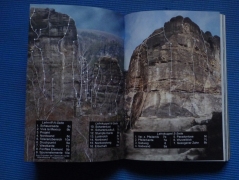During my first years climbing in the Sächsische Schweiz I had a very hard time trying to find routes using the available climbing guides. The drawn topos of Jürgen Schmeisser’s guides of Rathen and the Gebiet der Steine saved me many times from climbing the wrong route. Nevertheless, due to the lack of topos, big areas such as Schrammsteine, Affensteine, Zschand, Schmilka and the Wildensteiner Gebiet, were off-limits for me. In this areas, the amount of big peaks clustered together and their complex layout poses a great challenge for assembling a comprehensive guide with topos.
Finally, the team of R. Rassbach decided to step up to the challenge and publish an extraordinary climbing guide for the eastern areas of the Elbsandsteingebirge! What does this new guide bring to the table?
For starters, to my knowledge it is the first guide that includes photo-topos for the majority of peaks in it. The topos are in color and the contrast is very good so it is not a problem to follow the line of different climbs. Right next to the photos is the numbering guide to the route name with its corresponding grade, making it easy to quickly find the route you are interested in, a problem that was often found in older Schmeisser’s guides.
As with most other climbing guides, for all the routes the guide provides the first ascender, year of ascent, and a short description of the climbing line. Also, there are the traditional icons showing the style of the route (slab, vertical, roof, dihedral). The guide also offers recommendations with a well-known an intuitive star system. What also comes in very handy are extra icons or short phrases to assess how well-protected the route is and the rock quality. What is really novel and unique for this climbing guide are the short comments after the route description that give useful tips for the crux or just highlight key sections for the route.
Naturally, the task of creating a detailed photo-topo guide is no light endeavour. In this case, the authors decided not to make a complete guide of the areas but rather chose a selection of the most notable peaks and routes. This still makes for a very heavy tome, which is perhaps its major drawback. Most the routes reviewed are in the upper end of the difficulty grade, with comments on very few routes below the VIIIth grade. Therefore, the guide is primarily for experienced climbers. This is not strictly negative, as the useful information for the hardest routes in the Sächsische Schweiz is hard to come across. In my opinion, the only aspect with lots of room for improvement is the map section, which is not of the best quality and takes up plenty of space in the book.
In summary, the guide is a great new tool to explore the Sächsische Schweiz. Although its weight and size do not make it the best companion while outside, it is extremely valuable when trying to find a new project at home or the car. The detailed photos not only will give you tons of information, but will also inspire you for your next ascent! Unfortunately it is not possible to order it online and is only available at Bouldercity in Dresden. For more info visit the Buschfunk climbing database.


